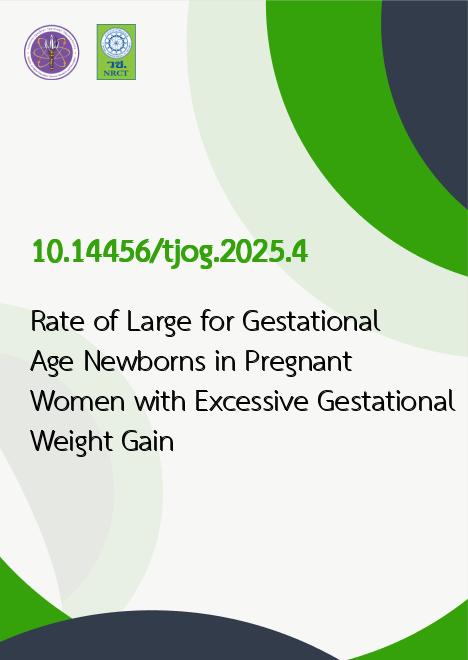
|
Rate of Large for Gestational Age Newborns in Pregnant Women with Excessive Gestational Weight Gain |
|---|---|
| รหัสดีโอไอ | |
| Creator | Harnnarong Chupool |
| Title | Rate of Large for Gestational Age Newborns in Pregnant Women with Excessive Gestational Weight Gain |
| Contributor | Fuanglada Tongprasert |
| Publisher | PIMDEE Co., Ltd. |
| Publication Year | 2568 |
| Journal Title | Thai Journal of Obstetrics and Gynaecology |
| Journal Vol. | 33 |
| Journal No. | 1 |
| Page no. | 35-43 |
| Keyword | gestational weight gain, excessive weight gain, large for gestational age, macrosomia, neonatal birth weight |
| URL Website | https://tci-thaijo.org/index.php/tjog/index |
| Website title | www.tci-thaijo.org |
| ISSN | 2673-0871 |
| Abstract | Objectives: To compare the rate of large for gestational age (LGA) newborns between pregnant women with excessive weight gain (EWG) and appropriate weight gain (AWG) Materials and Methods: A retrospective cohort study was conducted on pregnant women who delivered term singleton newborns between July 2020 and December 2021 at Maharaj Nakorn Chiang Mai Hospital. Pregnant women were classified as EWG and AWG regarding their pre-pregnancy body mass index (BMI) and gestational weight gain (GWG). LGA newborn was defined as birth weight > the 90th percentile for gestational age. Rates of LGA newborns, neonatal birth weight, pre-pregnancy BMI, and maternal and perinatal complications were compared between EWG and AWG groups. Results: There were 23.4%, 59.9%, and 16.7% of 1,182 pregnant women who had EWG, AWG, and poor weight gain (PWG), respectively. The rate of LGA newborns in the EWG group was statistically higher than in the AWG group (5.8% vs 2.8%, p = 0.026). Pregnant women in the EWG group had statistically higher neonatal birth weight (3,240 gm vs 3,080 gm, p < 0.001) and higher pre-pregnancy BMI (25.1 kg/m2 vs 22.0 kg/m2, p < 0.001) than in AWG group. Logistic regression analysis showed that obesity and nulliparity were the independent risk factors for LGA newborns. Conclusion: EWG was associated with a higher rate of LGA in newborns and was likely to occur in women with higher pre-pregnancy BMI and nulliparity. This study emphasizes the importance of preconception counseling and pregnancy education on nutrition and weight gain. |
